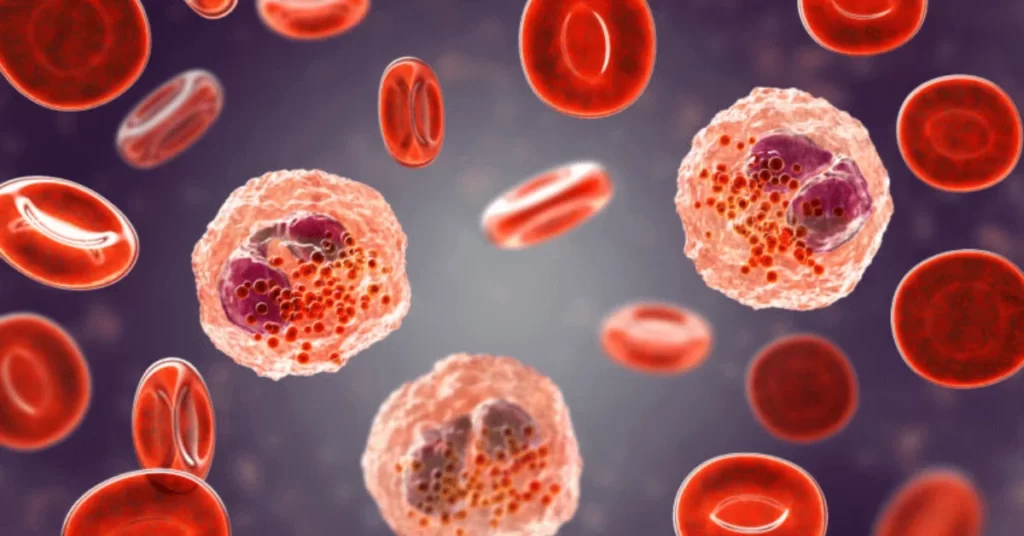Eosin absolute are white blood cells that are crucial to the immune system’s ability to combat infections and illness. Additionally, during allergic responses and asthma attacks, they support the body’s immunological response. Your immune system releases eosin absolute, which moves to the damaged area and kills the invasive cells when your body senses a threat such as harmful pathogens (such as parasites, viruses, or bacteria) or allergens.
What Are Eosinophils?
Eosinophils are a type of white blood cell, an essential component of our immune system. They play a vital role in defending our body against infections and are particularly involved in combating parasites. Eosin absolute are characterized by their distinct bilobed nucleus and granular cytoplasm, which contains specific granules that give them their name.
How To Measure Eosinophils
To measure eosinophils, a simple blood test known as a complete blood count (CBC) is conducted. The CBC provides an overview of various blood components, including eosinophils. A small sample of your blood is taken, and the laboratory analyzes it to determine the eosinophil count. The results are usually expressed as a percentage of the total white blood cell count.
Understanding Eosinophil Levels
Eosinophil levels can vary from person to person and are influenced by several factors. Normal eosinophil levels typically range from 1% to 6% of your total white blood cell count. Elevated levels may indicate an underlying medical condition, while low levels can also have implications.
Low Eosinophil Count
A low eosinophil count, known as eosinopenia, can result from various factors, including certain medications, stress, or acute infections. It’s essential to identify the underlying cause of low eosinophil levels and address it accordingly.
High Eosinophil Count
A high eosinophil count, known as eosinophilia, is a condition where the eosinophil count in the blood is elevated. Eosinophilia can be categorized as mild, moderate, or severe, depending on the count.
| Category | Eosinophil Count |
|---|---|
| Mild | 500-1,500/mm³ |
| Moderate | 1,500-5,000/mm³ |
| Severe | >5,000/mm³ |
Eosinophilia can be indicative of various conditions, including allergies, asthma, parasitic infections, autoimmune diseases, and even certain types of cancers. It’s essential to work with a healthcare provider to determine the underlying cause of high eosinophil levels.
How To Treat Eosinophilia
The treatment for eosinophilia depends on the underlying cause and the severity of the condition. In some cases, treatment may not be necessary if eosinophilia is mild and not causing any symptoms. However, if treatment is required, it typically involves addressing the root cause.
| Drug Class | Brand Name | Generic Name |
|---|---|---|
| Corticosteroids | Prednisone | Prednisolone |
| Anti-histamines | Zyrtec, Claritin, Allegra | Cetirizine, Loratadine, Fexofenadine |
| Anti-parasitic Drugs | Albendazole | Albendazole |
| Immunosuppressants | Cyclosporine | Cyclosporine |
The treatment may involve medications like corticosteroids to reduce inflammation, antihistamines to manage allergies, or anti-parasitic drugs to eliminate parasites. In some cases, immunosuppressants may be prescribed to control the immune response.
Review
Understanding your eosinophil count is crucial for maintaining your overall health. Whether it’s a low or high eosinophil count, it can be indicative of underlying health conditions. By working closely with your healthcare provider and following their guidance, you can manage and address any issues related to your eosinophil count effectively.
Frequently Asked Questions (FAQs)
1. What are eosinophils, and what is their role in the body?
Eosinophils are a type of white blood cell that plays a crucial role in the immune system, primarily involved in defending the body against infections and parasites.
2. How is the eosinophil count measured?
The eosinophil count is determined through a blood test called a complete blood count (CBC), and it is typically expressed as a percentage of the total white blood cell count.
3. What are the causes of a low eosinophil count?
Low eosinophil counts can result from factors like medication use, stress, or acute infections. Identifying the underlying cause is essential.
4. What are the common conditions associated with high eosinophil counts?
High eosinophil counts can be linked to allergies, asthma, parasitic infections, autoimmune diseases, and certain types of cancers.
5. How is eosinophilia treated, and are there specific medications for it?
The treatment for eosinophilia depends on its cause and severity. Medications like corticosteroids, antihistamines, and anti-parasitic drugs are commonly used to manage eosinophilia. The choice of medication depends on the underlying condition.






